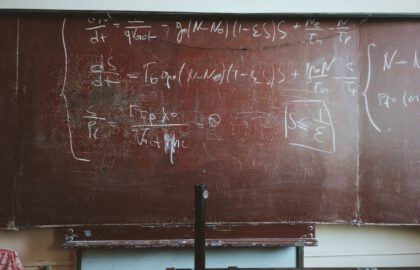
Python is a programming language that is continually growing in popularity. As a high-level language, Python emphasizes code readability over complexity. It uses an easy-to-follow indentation system, making it the go-to language for programmers and data scientists alike.
Here’s why you should consider learning to code in Python if you’re looking to practice data manipulation in any shape or form.
Why learn Python for data science?
Python is one of the most widespread coding languages in the world. Its place in the hierarchy of coding language can be vouched for by its community of passionate users and learners that's growing by the day.
The main reason for Python’s popularity is its simplicity and versatility. During the 2000s, people used to be intimidated by the thought of programming due to the difficulty and complexity of coding languages like C++, Java, and Lisp.
Python showed that you don’t need to be a computer genius or dedicate five years of your life to program and manipulate massive databases.
Python is easy to learn, in part, because it’s a high-level programming language. It's closer to spoken human languages than the binary language that machines operate in. While you’ll need to memorize a dozen or so reserved syntax words and formats, Python is written in English, allowing anyone to guess what a few lines of code do without having to run the program.
And unlike other languages, you can start using Python to analyze data sets even as a beginner. This is made possible by pre-programmed syntax that you can write and execute with tangible results early on in your learning journey. Later on, as you become familiar with more niche syntax commands — and even start creating your own — you’ll realize how powerful Python is, allowing you to perform tasks and operations quickly and efficiently.
Is Python better than R for data science?

There’s only one other language that has a reputation to contend with Python when it comes to data science, and that’s R — not to be confused with Ruby. While both R and Python are used regularly by data scientists and analysts, they both serve different roles in the operation.
Essentially, R is used exclusively for data analysis and statistics, whereas Python is a general-purpose language that is used across all different kinds of software engineering and data science.
While relatively similar in purpose and use, R and Python are not interchangeable when it comes to the four main pillars of data science: collection, exploration, visualization, and modeling.
They mainly differ in how they approach each pillar, providing results that look at the data from a different angle.

Data exploration
You can think of data exploration as the little sibling of data analysis. Data exploration is the process of scanning the data looking for underlying patterns and shared characteristics. Data exploration, however, isn’t used to uncover any substantial insights about the data, but is used to give scientists the bigger picture and help guide them through the stages to come.
R was designed to do this natively, while Python has achieved the same by using third-party libraries.
With Python, you can take advantage of its countless libraries to explore your data without having to write code from scratch. For instance, by using Pandas, you can filter, sort, and display data pairs and collections.
Alternatively, R is more statistical. R is good for directly filtering and viewing data as well as applying statistical tests. Specifically, R has built-in data types for vectors, matrices, and dataframes. Python doesn't have those by itself, but data scientists use the NumPy and Pandas libraries. These libraries have the added benefit of being written on top of C library code, meaning they can perform operations on large datasets significantly faster than R.
Statistical modeling
After collecting and exploring your data, comes the time to create a suitable model. Data modeling is the process of creating a data model, which is a set of abstract rules that determine how data elements relate to one another, often using properties of the real world. When models are used to make predictions about unseen data, we call that machine learning.
Python, on its own, makes it easy to create custom data modeling with some work. However, and similarly to data exploration, you can use code from ready-made Python libraries to establish your model. For example, you can model numerical data using Numpy or apply machine learning algorithms using scikit-learn. To get similar results as R, you'll have to rely on external packages, as its core functionality doesn’t support modeling.
Both Python and R can do statistical modeling, but R is really only designed for static analysis — basically, writing a paper or report. To deploy a model and have it be used for live decision-making in a website or app, Python has much better tooling. This is because Python is a truly general-purpose programming language, so it works well with software frameworks that also use Python, such as Django and Flask.
Without any external packages, R actually can do modeling (linear models), and Python can't.
Data visualization
As the name suggests, data visualization is the visual representation of data using graphs, charts, plots, and maps to better showcase your findings. While it may sound simple at first, data visualization is a delicate operation as the results of a low-quality visualization can be misleading and or hard to understand.
Python is generally more efficient for data exploration, and has been tooling for deploying models. Although, when it comes to data visualization, it’s a bit harder to use Python than R. Still, you can use a few of Python’s external libraries, such as Matplotlib and Seaborn to generate graphs and charts representing your findings.
Data visualization, however, is one of R’s greatest strengths as it was created to showcase the results of its statistical analysis. That’s why you can easily create sleek and unbiased graphics.
Is Python necessary in the data science field?
To work in data science, you'll need to learn at least one of two languages — Python or R. If you already have some experience with R, then it’s best to go through with it before starting with another language. On the other hand, if you’re new, start with Python due to its versatility.
However, by choosing to not learn Python, you may find yourself missing out on a lot of valuable opportunities in your career. Not to mention, wasting time and energy working out problems that you wouldn’t have faced using Python.
In 2018, 66 percent of data scientists reported using Python daily, while less than 50 percent said they use R.
Python is highly flexible and forgiving — two features that are incredibly important when handling massive volumes of data regularly. If you use the correct syntax and format, you can combine various algorithms to manipulate your data as needed. That can be a much harder feat in more rigid languages that require you to learn entirely new skills before you can perform a new type of operation or calculation on your data.
Even as a beginner, with a few months of Python experience and the help of the countless tutorials and guides available online, you can start processing and analyzing databases. Python can grow along with you. As you become more proficient, you can start using the various Python libraries available online to save time and energy. Not to mention, you can even create your own loops, conditionals, and syntax to cut back on work time and code density, making it easier to debug and revise your code for errors later on.
On your journey to mastering Python, it’s important that you take up courses and lessons that specialize in teaching Python for data science. After all, the skills you’ll need most in Python differ depending on industry and application. Fortunately, there are a variety of sources online to learn Python for free. Not to mention, you don’t need any special software or device to start practicing. All you’ll need to install is a Python source code, as well as a code editor. All of which are easy to find and free to use.
Where can I Learn Python for data science?
If you’re interested in launching a career in data science, or simply wish to learn Python for personal reasons, you can take advantage of the countless resources available online.
Online tutorials
Flatiron School offers a ton of resources and online classes to help you learn anything from software engineering and programming to data science and cybersecurity analytics. If you’re still not sure whether Python is for you, you can take Flatiron School’s free Python lesson that covers the basics.

In this free Python tutorial, you can learn:
-
Python basics
-
Python programming fundamentals
-
Python data types
-
Python data structures
-
Assigning lists to a variable
-
Editing & managing items in a list
By the end of it, you’ll have an understanding of the different Python data types and basic skills on how to assign a list to a variable, compare lists, and use the index of the items in your lists.
Books
Bootcamps and online lessons aren’t the only way you can learn Python. You can use books to teach yourself Python at your own pace, specializing in the category of your choice while practicing as much as you need. Here a few books worth checking out:

-
Python for Everybody: Exploring Data Using Python 3: This book was written by Dr. Charles R. Severance, a Clinical Associate Professor and Python teacher at the University of Michigan. It is designed to introduce beginners to Python programming and software development through the lens of exploring data.
-
Learning Python: This book was written by Mark Lutz, one of the world leaders in Python training, teaching over 4000 students and instructing over 250 training sessions. It is a comprehensive, in-depth introduction to the world of Python. With techniques on how to efficiently write high-quality code, it’s suitable for both professional developers and beginners looking to dip their toes into the Python world.
-
Python for Data Analysis: This book was written by Wes McKinney, a software developer and the creator of the open-source Pandas, which is used widely for data analysis. This book is a hands-on guide that offers step-by-step instructions on manipulating, processing, and cleaning datasets in Python. It also includes real-life case studies to develop your problem-solving abilities.
Bootcamps
If you’re confident in your decision to pursue data science, you can apply for the data science bootcamp at Flatiron School that you can complete in 15 weeks or via one of the flexible pacing options. The bootcamp is beginner-friendly, and covers everything from the basics of data science to Python, which occupies a big part of the bootcamp's curriculum.




